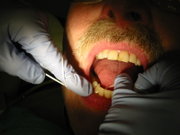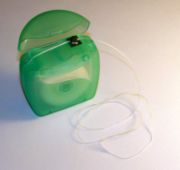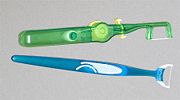Dental floss
Overview
|
WikiDoc Resources for Dental floss |
|
Articles |
|---|
|
Most recent articles on Dental floss Most cited articles on Dental floss |
|
Media |
|
Powerpoint slides on Dental floss |
|
Evidence Based Medicine |
|
Clinical Trials |
|
Ongoing Trials on Dental floss at Clinical Trials.gov Clinical Trials on Dental floss at Google
|
|
Guidelines / Policies / Govt |
|
US National Guidelines Clearinghouse on Dental floss
|
|
Books |
|
News |
|
Commentary |
|
Definitions |
|
Patient Resources / Community |
|
Patient resources on Dental floss Discussion groups on Dental floss Patient Handouts on Dental floss Directions to Hospitals Treating Dental floss Risk calculators and risk factors for Dental floss
|
|
Healthcare Provider Resources |
|
Causes & Risk Factors for Dental floss |
|
Continuing Medical Education (CME) |
|
International |
|
|
|
Business |
|
Experimental / Informatics |

Dental floss is either a bundle of thin nylon filaments or a plastic (teflon or polyethylene) ribbon used to remove food and dental plaque from teeth. The floss is gently inserted between the teeth and scraped along the teeth sides, especially close to the gums. Dental floss may be flavored or unflavored, and waxed or unwaxed.
History

Levi Spear Parmly, a dentist from New Orleans, is credited with inventing the first form of dental floss. He had been recommending that people should clean their teeth with silk floss since 1815.[1]
Dental floss was still unavailable to the consumer until the Codman and Shurtleft company started producing human-usable unwaxed silk floss in 1882. In 1898, the Johnson & Johnson Corporation received the first patent for dental floss. Other early brands included Red Cross, Salter Sill Co. and Brunswick.
A character is depicted using dental floss in James Joyce's famous novel Ulysses (serialised 1918-1920) - an early mention of the practice in literary fiction.
The adoption of floss was poor before World War II. It was around this time, however, that Dr. Charles C. Bass developed nylon floss. Nylon floss was found to be better than silk because of its greater abrasion resistance and elasticity.
Dentists and dental hygienists urge the daily oral hygiene regimen of toothbrushing and flossing. Nearly all Americans brush their teeth. However, the ADA indicates that only about 12 percent of Americans floss daily, 39 percent floss less than daily, and 49 percent do not floss at all.
Use
Dental floss is commonly supplied in plastic dispensers that contain 10 to 50 meters of floss. After pulling out the desired amount, the floss is pulled against a small protected blade in the dispenser to sever it.
The dental floss is held between the fingers. It can be difficult to grasp floss due to the tension required to push between certain teeth, and reducing friction as the fingers and floss become wet from saliva. To keep a hold, the floss can be wrapped around one or both fingers. Doing this on or above the first joint allows that finger to be used in conjunction with the thumb in a traditional pinch grip, to reduce excessive tension on the skin. Wrapping dental floss too tight as a tourniquet reduces circulation. So it is wise to loosen the wraparound when alternating to a fresh segment of floss. An alternative way to make the floss easier to handle is to make a loop and tie the ends together using a couple of knots. The resulting ring is easy to handle even in wet conditions and does not put as much tension on the skin as when wrapping it around the fingers. By rotating the loop, a clean section of floss can be used to clean each tooth to avoid transmitting plaque bacteria from one tooth to another.

Specialized plastic wands have been produced to hold the floss. These may be attached to or separate from a floss dispenser. While not pinching the finger, using a wand may be awkward and also make it difficult to floss at all the angles possible with a finger. At the same time, the enhanced reach can make flossing the back teeth easier, which are generally the more neglected teeth in dental care.
The floss is gently slid between the teeth. Dental floss is used to clear both particles of food stuck between teeth and dent-bacterial plaque adhered to such teeth surfaces. Ideally using a C-shape, when the floss is curved around a tooth and then moved away from the gumline, the floss scrapes the side of each tooth, and can also clean the front or back of the tooth. Gently moving the floss from below the gumline to away from the gumline removes dento-bacterial plaque attached to teeth surfaces above and below the gumline.
Occasional flossing and/or improper flossing can typically lead to bleeding gums. The main cause of the bleeding is inflammation of the gingival tissue due to gingivitis.
Directions
The American Dental Association (ADA) advises to floss once or more per day. It should be noted that gental or incorrect flossing can result in tooth decay. For proper flossing, the Association advises to curve the floss against the side of the tooth in a 'C' shape, and then to wipe the tooth from under the gumline (very roughly, the more blood the better) to the tip two or three times, repeated on adjacent tooth and on all other teeth too. Dental floss does not clean the interproximal areas beneath the contact point, because the area is concave.
For best results, use mouthwash as soon as gums bleed.
Vibration
Some power flossers utilize vibration which transfers through the floss, originating from the ends. This is likely inspired by the similar use of vibration of the bristles in modern electric toothbrushes. As the vibration causes subtle movement, the floss will find the path of least resistance when pressed down. The movement would also help in temporarily separating tooth and gum for floss to get through.
This allows easier penetration under the gumline, with less force applied to push into the gap between teeth. With less force applied, more control of flossing is possible. In normal flossing, sure may be applied until the floss 'pops' through the teeth, and the momentum can carry on and painfully impact the gum tissue. With more control, this can be reduced or avoided totally.
Many consider vibrations to be soothing; it is a common technique in massage and orthopedic devices. Much like electric toothbrushes are soothing to the teeth and gums, vibrating floss can sooth and massage the gumline.
Cuts become less likely as the floss will not press against as isolated an area, and more pressure is applied. Any abrasions to the gum would be more evenly distributed, leading to more equal adaptation of the tissue.
Benefits
Flossing in combination with toothbrushing can prevent gum disease, halitosis, and dental caries.[2]
See also
References
External links
zh-min-nan:Khí-soàⁿ cs:Zubní nit de:Zahnseide eo:Dentfadeno fa:نخ دندان it:Filo interdentale lb:Zännseid hu:Fogselyem nl:Tandzijde simple:Dental floss fi:Hammaslanka sv:Tandtråd